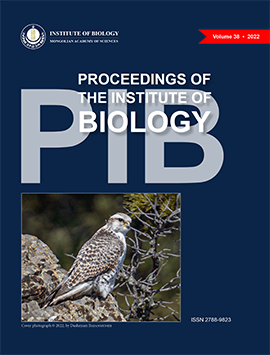Movement and home range of Wapiti in Hustai National Park
DOI:
https://doi.org/10.5564/pib.v38i1.2535Keywords:
Wapiti, satellite collar, movement, home rangeAbstract
Six individuals were tracked between June 2019 and August 2021 to gather a total of 12,400 points of data for the purpose of researching the wapiti’s movement and home range in the Hustai National Park (HNP). The period for each individual depended on the satellite collar operation and wapiti mortality. In the HNP, wapiti travel an average daily distance of 2,944 ± 260 meters, and have home ranges from 98 to 529 km2 . Seasonal changes in the animal’s biological and ecological features, as well as the conditions of its habitat, have a direct impact on the size of the animal’s movement and home range.
Хустайн байгалийн цогцолборт газрын халиун бугын шилжилт хөдөлгөөн, байршил нутгийн онцлог
ХБЦГ-ын халиун бугын шилжилт хөдөлгөөн, байршил нутгийг судлах зорилгоор зургаан бодгальд хүзүүвч зүүж 2019 оны VI сараас 2021 оны VIII сарыг дуустал нийт 12,400 цэгэн мэдээлэл хүлээн авсан. Хүзүүвчний ажиллагаа болон бугын үхэл хорогдлоос шалтгаалан бодгаль тус бүрийн мэдээлэл өгсөн хугацаа ялгаатай байв. Хустайн нурууны халиун бугын хоногт шилжсэн зай дунджаар 2,944 ± 260 метр, байршил нутгийн хэмжээ 98-529 км2 талбайд хэлбэлзэж байна. Шилжилт хөдөлгөөн, байршил нутгийн талбайн хэмжээ улирлаар ялгаатай бөгөөд тухайн зүйл амьтны биологи-экологийн онцлог, амьдрах орчны нөхцөлөөс шууд хамаарна.
Түлхүүр үгс: халиун буга, байршил дамжуулах хүзүүвч, шилжилт хөдөлгөөн, байршил нутаг
Downloads
438
References
Lebedev V. S. et al, “A revised checklist of Mongolian mammal species,” Erforschung biologischer Ressourcen der Mongolei / Exploration into the Biological Resources of Mongolia, pp. 349–360, 2016.
IUCN, “Cervus canadensis: Brook, S.M., Pluháček, J., Lorenzini, R., Lovari, S., Masseti, M., Pereladova, O. & Mattioli, S.: The IUCN Red List of Threatened Species 2018: e.T55997823A142396828.” International Union for Conservation of Nature, Jan. 25, 2015. https://doi.org/10.2305/IUCN.UK.2018-2.RLTS.T55997823A142396828.en
Report on “Study to determine the movement and distribution areas of Mongolian Gazelle, Argali Sheep, White-naped Crane, and forest animals in ecological regions that are not fully covered by creating connections between specially protected areas,” Ulaanbaatar, 2018. (in Mongolian)
“Assessment of distribution and resources of mountain ungulates of Mongolia,” Proc. Inst. Biol. Ulaanbaatar, 2010. (in Mongolian)
Dulamtseren S., “Some news about the ungulates of the Eastern and North-Eastern Khangai Forests,” Proc. Inst. Biol. no. 7, 1973. (in Mongolian)
Usukhjargal D., “Research and conservation management of Red Deer (Cervus elaphus Linnaeus, 1758)”, Proc. Inst. Biol. no. 25, 2005. (in Mongolian)
Lkhagvasuren B. et al., “The current state of Red Deer (Cervus elaphus) in the Khangai and Khentii mountains,” Proceedings of Hustain Nature Park, no. 7, 2006. (in Mongolian)
“Remote Sleep System,” Pneu-Dart, Jan. 21, 2022. http://www.pneudart.com/
“Photography of Vegetation.” https://eic.mn/geodata/download.php (accessed Jan. 21, 2022). (in Mongolian)
Uuganbayar G., “Red Deers of the HNP,” Takh, no. 13, 2018. (in Mongolian)
Samiya R. et al., “Determining the range, resources, and proper use of Wapiti, and determining the conservation status,” Department of Biology, Ulaanbaatar, NUM, 2022. (in Mongolian)
B. Georgii, “Home range patterns of female Wapiti (Cervus elaphus L.) in the Alps,” Oecologia, vol. 47, no. 2, 1980, https://doi.org/10.1007/BF00346833.
J. F. Kamler, W. Jedrzejewski, and B. Jedrzejewska, “Home Ranges of Wapiti in a European Old-growth Forest,” Am Midl Nat, vol. 159, no. 1, 2008, https://doi.org/10.1674/0003-0031.
R. Kropil, P. Smolko, and P. Garaj, “Home range and migration patterns of male Red Deer Cervus elaphus in Western Carpathians,” Eur J Wildl Res, vol. 61, no. 1, Feb. 2015, https://doi.org/10.1007/s10344-014-0874-4.
Downloads
Published
How to Cite
License
Copyright (c) 2022 Myanganbuu Nyamkhuu, Gansukh Sukhchuluun, Galsandorj Naranbaatar, Yansanjav Adiya

This work is licensed under a Creative Commons Attribution-NonCommercial 4.0 International License.
Copyright on any research article in the Proceedings of the Institute of Biology is retained by the author(s).
The authors grant the Proceedings of the Institute of Biology license to publish the article and identify itself as the original publisher.
![]()
Articles in the Proceedings of the Institute of Biology are Open Access articles published under a Creative Commons Attribution-NonCommercial 4.0 International License - CC BY NC.
This license permits use, distribution and reproduction in any medium, provided the original work is properly cited.




